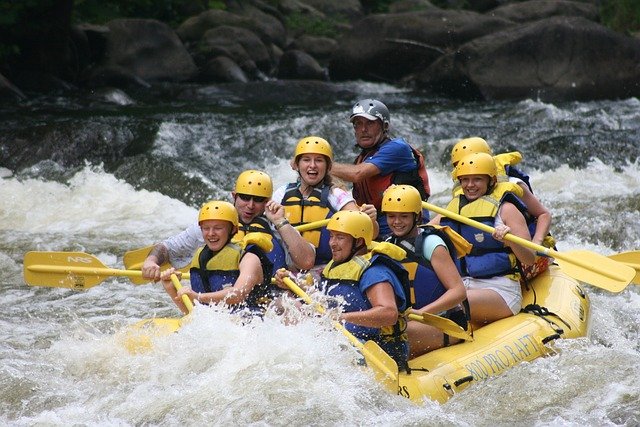Whitewater rafting is an adventure sport in which a raft is used to navigate a river or any water body. It is usually done on rapids or whitewater to keep up the excitement. It’s exhilarating and perfect for adrenaline junkies… whitewater rafting – not for the faint of heart!
A river goes through different gradients and flows from a higher gradient to a lower gradient. When the river’s gradient becomes sharp, frothy water is formed consisting of bubbles and aerated water. This has a white appearance hence termed whitewater. The sport has been popular since the mid-’80s.
Whitewater rafting is suitable for all age groups as various types of rapids are available for different tastes and levels of experience. Almost anyone with reasonable health can go for whitewater rafting. It is a good way to spend a vacation, travel abroad, be among nature, get the sun and of course get a tan.

It is considered a good way to release stress. The expeditions range from a day to a month. Whitewater rafting is now widely practised throughout the world.
The essential gear required for whitewater rafting is a raft. The inflatable boat is the most common raft used. It is made up of layers of durable rubber fabrics and independent air chambers. Various sizes are available ranging from 11 ft to 20 ft. Whitewater kayaks are also popular.

They are made of plastic or fibreglass. Safety gear, waterproof bags & cases, hooks, knives, ropes and camping equipment are essential. Almost all these are available on hire.
April to October is a good time. For thrill-seekers, May & June are suitable when the rapids are more turbulent. Whitewater rafting is done throughout the world around the year.

Whitewater is classified into 6 categories depending on the difficulty:
• Class I: Smooth water but fast.
• Class II: A little bit of rough water with eddies and easy drops
• Class III: Whitewater with rapids irregular waves, and back eddies. Swimming and self-rescue knowledge is a must.
• Class IV: Whitewater with whirlpools, and high irregular waves, for experienced adventurers.
• Class V: Whitewater with dangerous obstacles, violent rapids, boiling eddies. Scouting is essential before going on such expeditions
• Class VI: Extremely dangerous unexplored rapids.
Due to the interaction of rivers and riverbeds, various features like strainers, eddies, waves, pillows and holes are formed. The passage of water through large objects, (usually boulders) causes a strainer. Holes are formed when water pours on top of submerged objects that cause the water to flow backwards which rushes over the object. Waves are fronts formed on water’s surface flowing down.

Eddies are swirls or rotating water flow. When a large volume of water suddenly comes against an obstruction, the water flows to a certain limit over the obstruction causing a pillow.
The popular destinations are the South Fork American river, Colorado river, Arkansas river, Salmon river, Merced, and Kaweah in the US. Rivers in Quebec and British Columbia in Canada. Ganga Yamuna and Teesta rivers in India.
There has been concern by environmentalists due to activities of whitewater rafters like dredging the river bed. However, white water rafting also contributes to the local economy.
This is a sport you need to properly prepare for and that includes a good night’s sleep
